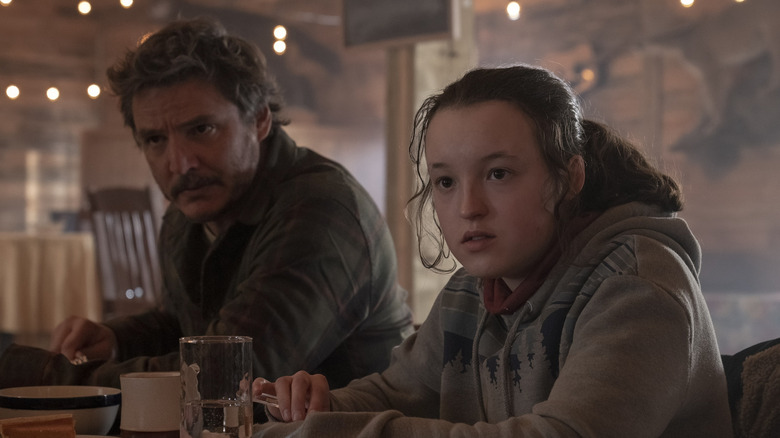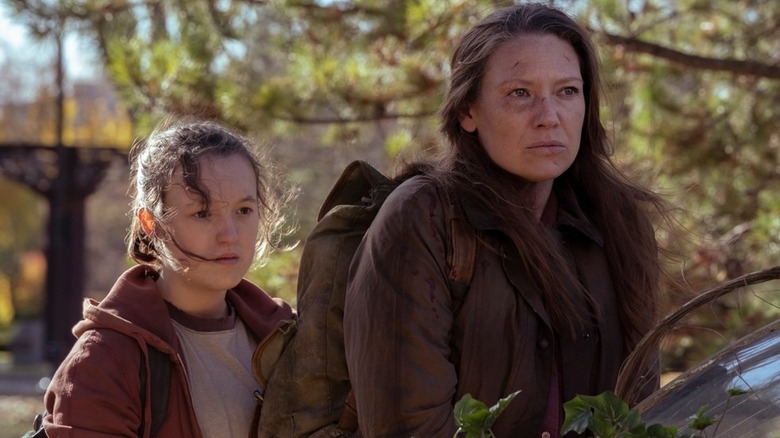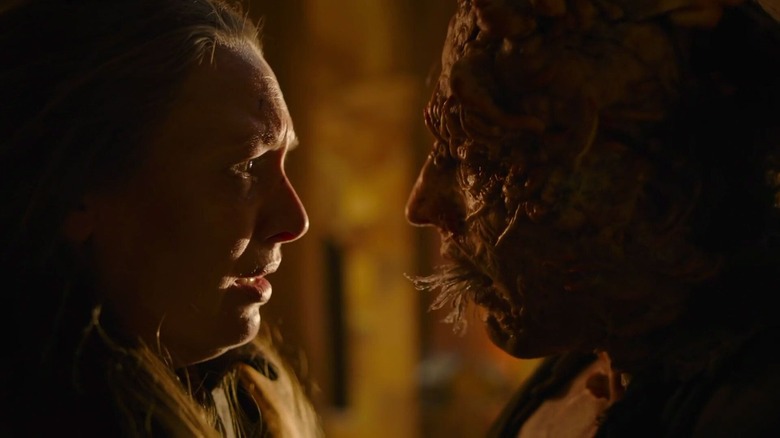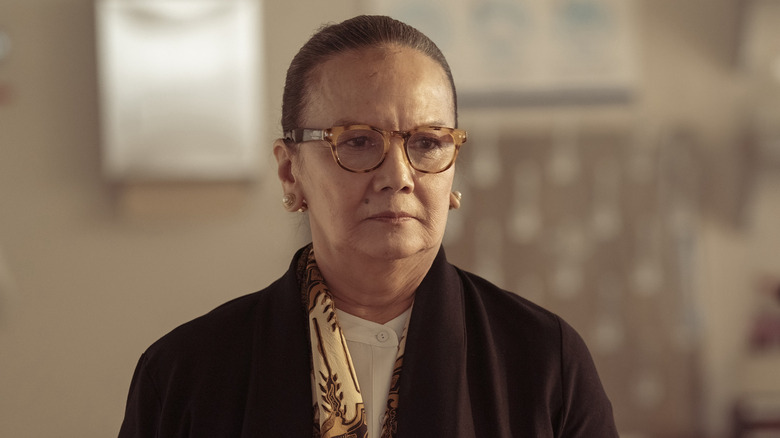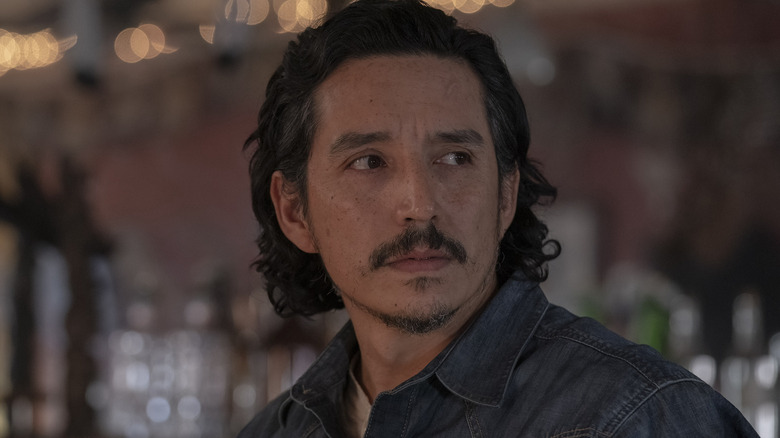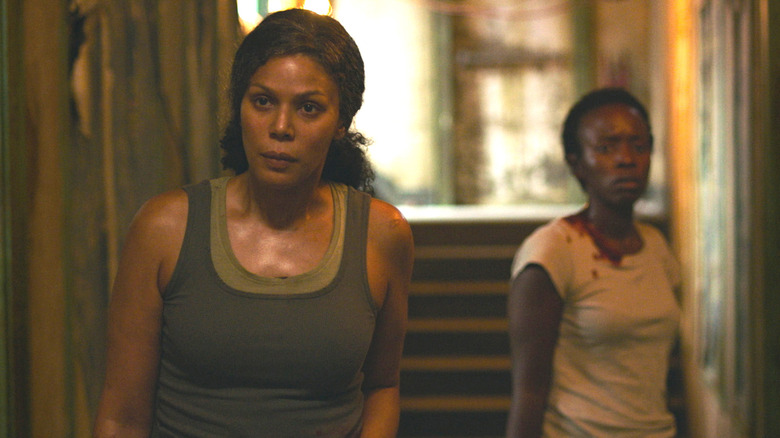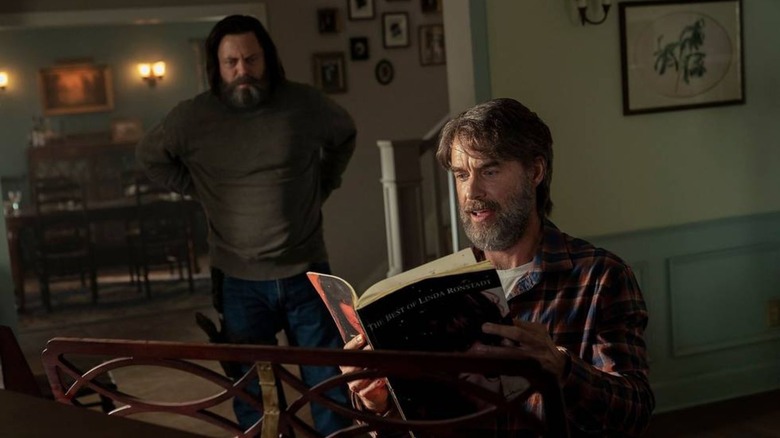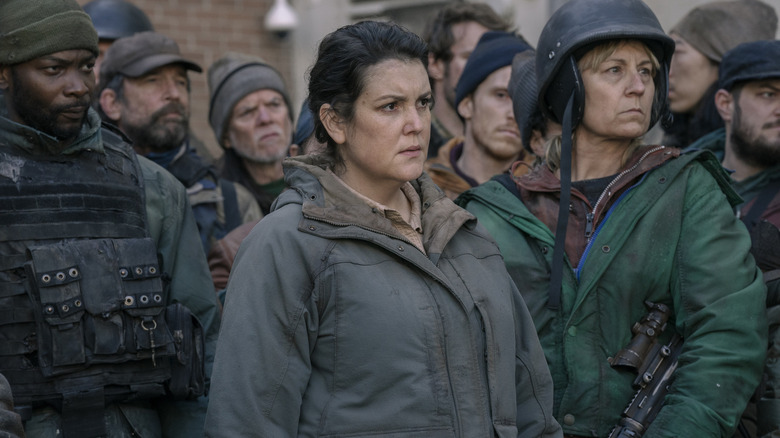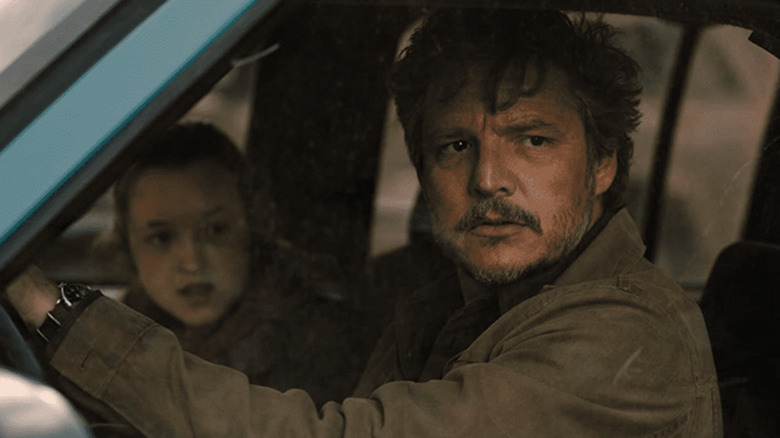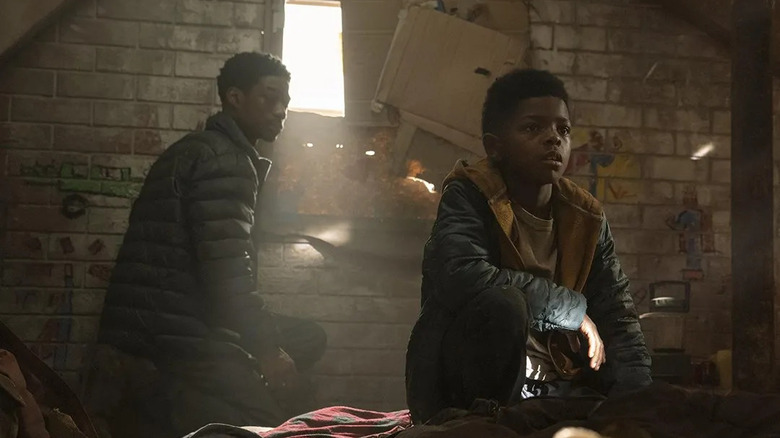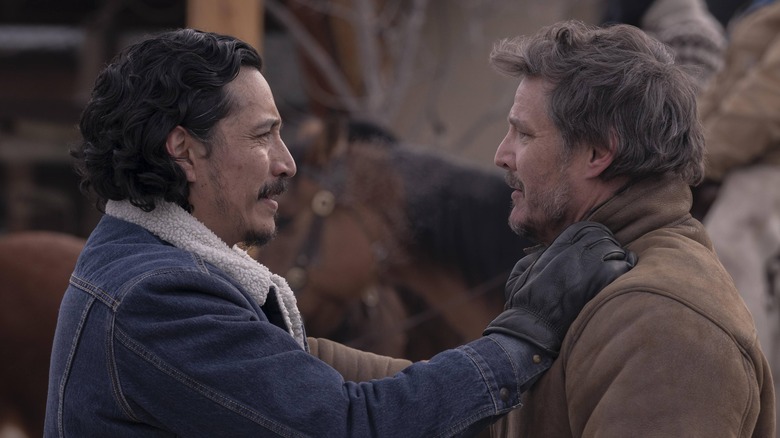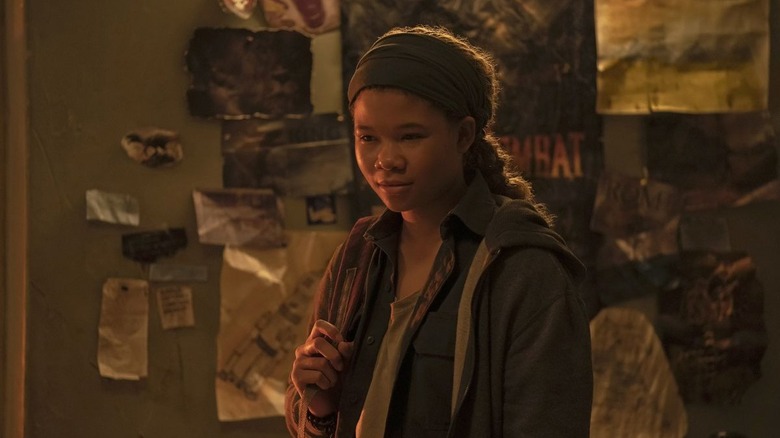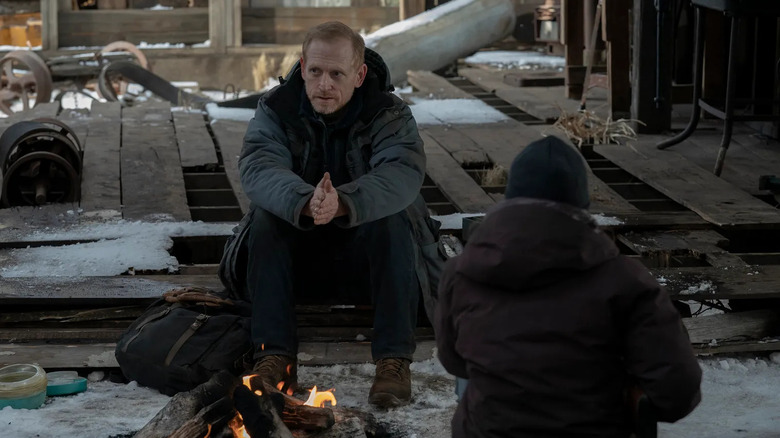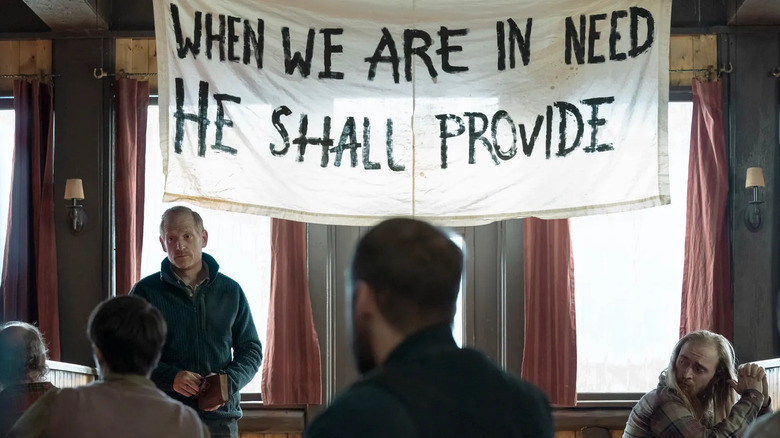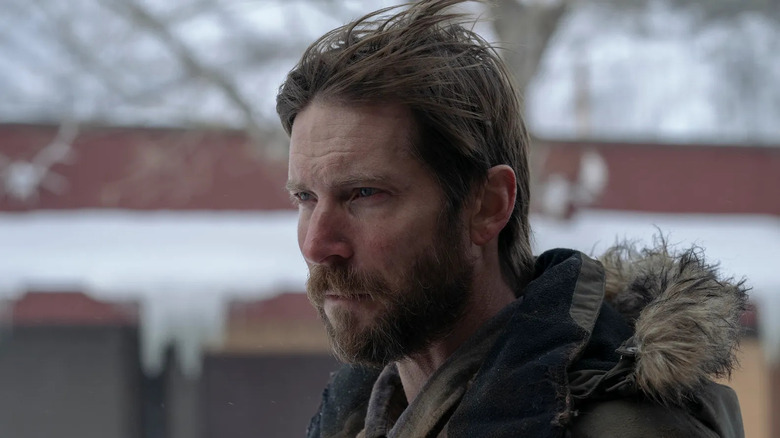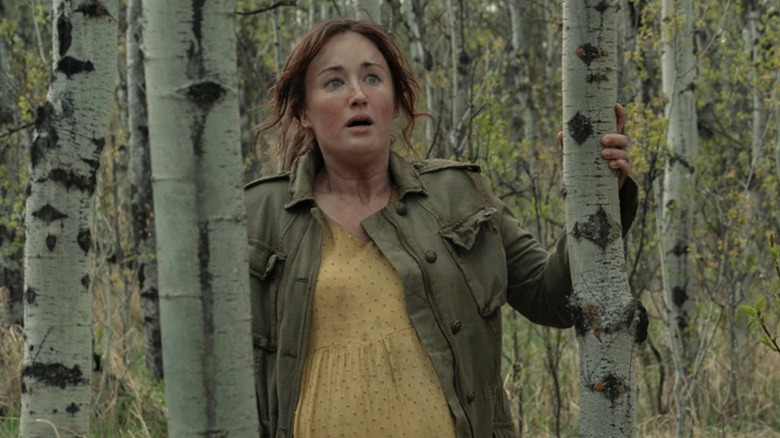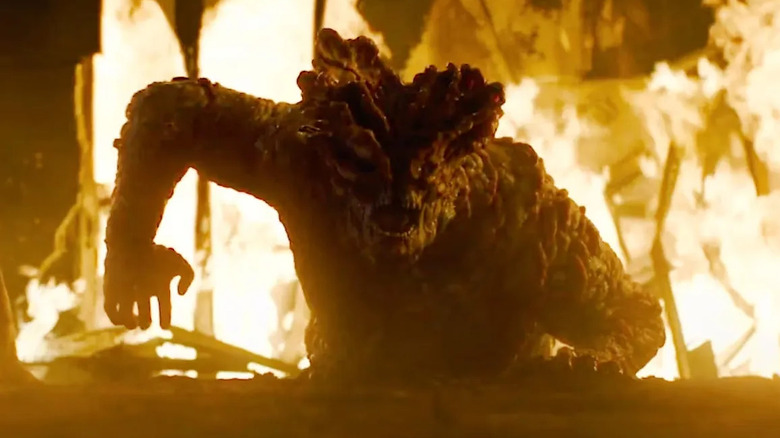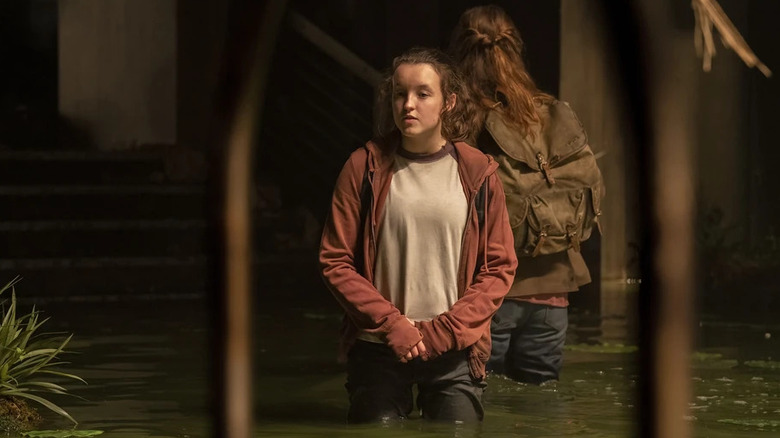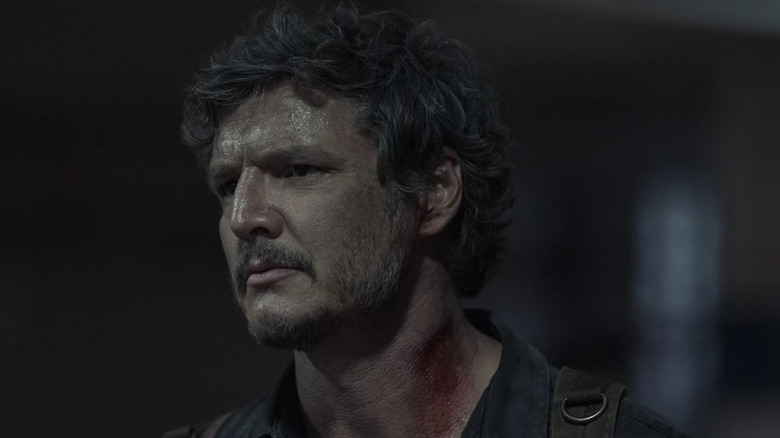The Last Of Us: The Biggest Differences Between The Show And The Game Explained
"The Last of Us" may have been one of HBO's most anticipated series ever before its premiere on January 15, 2023. However, few could have predicted just how well the show has been received by both critics and viewers, holding a 97% critic rating and a 91% audience score on Rotten Tomatoes as of this writing. The show is so good that many believe it may redefine how people view live-action video game adaptations, seeing the potential for intense, dramatic storytelling.
While "The Last of Us" remains remarkably faithful to the beloved video game that inspired it, like all good adaptations, the show has taken several creative liberties and made some changes. Understandably, some fans will always be wary of any changes to a story that's as well-loved as "The Last of Us," but many of these adjustments utilize the medium to help highlight story elements that may have been more difficult to tell in the game.
Although the journey of Joel (Pedro Pascal) and Ellie (Bella Ramsey) has remained mostly untouched, many of the supporting characters and the world they live in have been built upon and expanded in the HBO series. Some of these changes might be minor, while others play a larger role in how the story plays out. Here are some of the biggest differences between "The Last of Us" show and the game.
More points of view
Like many video games, the points of view in which the players experience the story of "The Last of Us" in the video game are quite limited. The story is primarily seen through the eyes of the protagonist, Joel, with only brief moments that put players in control of his daughter, Sarah, and the game's deuteragonist, Ellie. By keeping the story limited in scope, the game helps to place players firmly into the shoes of the main protagonists, helping them to feel immersed in the game's world.
HBO's "The Last of Us" uses its change in medium to flesh out the supporting characters in a way that was difficult for the game to achieve without breaking said immersion. This change in direction is apparent from the very first episode when viewers get to experience more of Sarah's (Nico Parker) day prior to the collapse, including how she fixes Joel's watch.
The show continues this trend, giving viewers insight into the world through the eyes of characters such as Tess (Anna Torv), Bill (Nick Offerman), and Henry (Lamar Johnson). It even provides some brief points of view from minor characters, such as the unnamed child in Episode 1 that appears just after the 20-year time jump.
Spores vs. Tendrils: How the infection spreads
There are a lot of ways in which "The Last of Us" sets itself apart from "The Walking Dead" and other zombie shows, but one of the biggest examples is how the walkers come to be the way they are. While "The Walking Dead" sets up a viral infection as the culprit, leading to the rise of zombies and the fall of civilization, the walkers in "The Last of Us" are infected by a fungus, based on the real-life fungus, cordyceps. In the show and video game, the cordyceps infect the human brain, taking control of the host and turning them into husks that resemble traditional zombies, with some even further mutating into clickers and bloaters.
Cordyceps is used as the means of infection in both the game and the show, but the series actually makes some surprising changes to how the fungus works and spreads. In the game, cordyceps is primarily spread through airborne fungal spores, which often necessitates that characters wear masks. The fungus can also be transmitted through bites from other infected, like many other zombie properties.
In the show, the fungus can no longer spread through spores in the air, and can only be transmitted through physical contact such as bites, or ingested through a food supply. The show's version of cordyceps also gives the infected tendrils that allow them to communicate with other infected through the mycelium network going through the ground.
The collapse of society
"The Last of Us" video game provides only some glimpses into the collapse of society that takes place between the introduction and the 20-year time jump that sets up the rest of the story. Most of that information can be gleaned by inquisitive players during the game's introductory segment in which players take control of Joel's daughter, Sarah. If players explore a bit, they can read a newspaper and view a news segment on television that give brief insights into the collapse around where she lives in Texas. In "The Last of Us: Part II," players can also locate a patient's note that explains that the infection likely began in South America.
In HBO's "The Last of Us," the beginning of society's collapse and the spread of the cordyceps infection has changed quite a bit. Unlike in the video game, viewers get to see how the infection began to spread via a flashback in Episode 2 ("Infected"). The flashback shows that the infection actually began in Jakarta, the capital city of Indonesia. After several workers were infected while working at a flour mill near the city, mycologist Ratna Pertiwi (Christine Hakim) is called in to assess the situation, to which she gives the recommendation that the Ministry of Defense bomb the city.
Joel's reason for taking the job
Joel isn't always the easiest hero to root for, as even he himself has admitted that he's done some pretty terrible things in his life. However, the HBO show softens the character up a bit from his counterpart in the video game, making family a bigger priority in the character's life and motivations. This subtle but important change not only helps to make the character more relatable and set up his relationship with Ellie later in the game, but it also changes some of his motivations throughout, including the reason that he agrees to help smuggle Ellie out of the city for the Fireflies.
In the game, Joel and Tess are looking to buy a shipment of guns from a smuggler named Robert to resell for a profit. However, Robert double-crosses them, selling the guns to Marlene and the Fireflies instead. After Roberts's death, Marlene agrees to give Joel and Tess their guns back, even doubling them, if they agree to smuggle Ellie out of the quarantine zone. In the show, Joel is worried about his brother, Tommy (Gabriel Luna), who hasn't made contact in some time and wants a car battery to get to his brother in Wyoming. This change makes Joel more family-oriented, prioritizing his brother over profits, while in the game, the two are estranged.
Ellie's relationship with the Fireflies
Like Joel's relationship with Tommy, Ellie's relationship with the Fireflies, and Marlene (Merle Dandridge) in particular, seems to have changed somewhat in the show. In the video game, when players first encounter Ellie, she is with Marlene who tells her to go with Joel and Tess. Ellie protests, worried about Marlene's safety. Throughout the game, Ellie describes her relationship with Marlene, always wondering whether she was safe. The two seem to be very close, with Ellie referring to her as a friend.
In the show, however, when viewers first meet Ellie, she has an antagonistic relationship with the Fireflies and Marlene who are holding her against her will. Apart from holding her captive, Ellie seems to have little knowledge of the Fireflies, or who Marlene is. After a few visits, Marlene finds common ground with Ellie by telling her that she was a friend of her mother. While Ellie and Marlene seem okay working with each other until Joel and Tess arrive, it's clearly not the close friendship described in the game. In addition, Ellie seems more antagonistic towards Tess and especially Joel when they first meet, and it takes her longer to warm up to him, while in the game it is the other way around.
The story of Bill and Frank
Arguably one of the biggest changes in HBO's "The Last of Us" revolves around Bill, a supporting character that Joel meets early on in the video game. In the game, Bill is a solitary survivalist that lives in a small trap-filled town outside of the Boston Quarantine Zone. After losing Tess, Joel takes Ellie to see Bill in order to secure a vehicle and some supplies. Joel, Bill, and Ellie have to fight off the infection while looking for a battery. While they do so, they encounter the body of Bill's former partner, Frank, who had a falling out with Bill sometime before the game and took his own life after being infected.
The show takes a very different approach to the character's story in Episode 3 ("Long, Long Time"), which chronicles Bill's life since the collapse, including meeting Frank (Murray Bartlett). While the game hints that they may have been romantic partners, the show outright confirms this, showing how the two fell in love. Unlike the game, the two never have a falling out. Instead, after 15 years together, Frank develops a neurodegenerative disease and chooses to end his life once the disease progresses. In the show, Bill chooses to end his own life at the same time, not wanting to live without Frank. Ellie never gets to meet Bill in the show, but he is able to leave a working vehicle and supplies to set Joel up for the road ahead.
New characters
Since "The Last of Us" series is able to introduce more points of view throughout the show, it has the benefit of being able to include not only a wider range of characters but also develop their motivations in a detailed way that the game was never able to. This provides the show with the unique opportunity to introduce new characters that never appeared in the game. Even in just the first half of the season, the show has already introduced several new characters into the fold.
Some of these characters only appear in a single brief, albeit important, scene. For instance, actor John Hannah, who's known for his roles in popular films such as "Four Weddings and a Funeral" and "The Mummy," plays Dr. Neumann, a scientist who appears in a TV interview in 1968. While he only appears in a single scene, his interview sets up how the fungus would be able to mutate to infect humans.
In another episode, viewers are introduced to mycologist Pertiwi, who tries to stop the spread of the cordyceps in Jakarta. However, the most important new character is Kathleen, played by Melanie Lynskey, and her sidekick Perry, played by Jeffery Pierce (who voiced Tommy in the video game). Kathleen is a revolutionary leader turned warlord who has taken control of Kansas City.
Pittsburgh or Kansas City?
Another major change between "The Last of Us" video game and the show is the location where Joel and Ellie are ambushed and lose their vehicle. In the video game, the pair are passing through Pittsburgh when they fall into a trap set by local bandits and end up losing their vehicle. They have to make their way through the city on foot while being hunted by an unnamed faction that overthrew FEDRA in the city. Much of Pittsburgh is flooded, including a major segment in a partially submerged hotel that Joel and Ellie encounter much earlier in the show while still in Boston. Eventually, they meet up with Henry and Sam and escape the city together.
In the show, Joel and Ellie are much further west on their journey to Wyoming. Instead of being ambushed in Pittsburgh, they are instead attacked while passing through Kansas City, Nebraska. Like the game's Pittsburgh segment, Kansas City is under the control of a revolutionary faction that overthrew FEDRA, before becoming tyrants themselves. In the show, the faction is given a leader, Kathleen, and viewers are able to see the hunt for the two from the other side. Like in the game, Joel and Ellie meet up with Henry and Sam (Keivonn Woodard), who are instrumental in their escape.
Henry and Sam's backstory
Like Bill and Frank, Henry and Sam are two supporting characters from "The Last of Us" game that Joel and Ellie meet for a brief time while escaping from the hostile city of Pittsburgh. In the game, Henry and Sam are brothers, and like Joel and Ellie, they were traveling through the city when they are ambushed by the local militant faction. After escaping, they went into hiding in the city, while Henry devised a plan to escape, which he was only able to do with Joel's assistance. Sam, Henry's younger brother, is about Ellie's age, and the two bond before he is bitten and becomes infected.
In the show, Henry are Sam were residents of Kansas City during FEDRA's rule. To afford medicine for Sam, Henry sold secrets about the revolutionary faction which resulted in the death of Kathleen's brother. Once Kathleen's group overthrows FEDRA, she mercilessly sets out to capture and kill Henry, trying to avenge the death of her brother. With the help of a local doctor, Henry and Sam are able to hide until Joel and Ellie arrive, giving them the opportunity to escape.
In the show, Sam is younger than his game counterpart, and is also deaf, using a magic slate paper saver to communicate with Ellie. Sadly, he and his brother meet the same tragic fates as they did in the game after Sam is bitten and Henry takes his own life, unable to cope with losing his brother.
A less eventful family reunion
Going into Episode 6 of "The Last of Us," titled "Kin," it was looking like the biggest change between the show and the video game would be Tommy's relationship with Joel, which is far more strained in the video game after the two had a falling out. However, as it turned out, quite a lot of the story has been changed, or rather, seems to be missing. While the episode still sees Joel reunite with his brother Tommy in the small town run by Tommy's new wife, Maria, the visit is considerably less action-packed in the HBO series.
In the video game, Joel and Ellie arrive in Tommy's new town (the Jackson community) just before it is attacked by a band of raiders. Joel and Tommy are split up from Ellie and Maria while working together to fight off the raiders. In addition, after saving the town, Ellie steals a horse and runs away, upset that Joel is trying to convince Tommy to take her to the Fireflies instead of doing it himself. While it would have been nice to see the brothers fight together in the HBO series, "The Last of Us" show chooses to focus more on the relationship dynamics between the characters.
A shift in focus on Left Behind
After the success of "The Last of Us" video game, developer Naughty Dog released a DLC chapter that took place after Joel's injury at the university, which puts players into Ellie's shoes as she struggles to keep him alive. The DLC was titled "The Last of Us: Left Behind," and the show's episode with the same name adapts that chapter's storyline. Overall, the episode is a very faithful adaptation of "Left Behind," although it shifts the focus away from the action seen in the video game to highlight Ellie's relationship with an old friend — Riley.
In the video game, "Left Behind" is split pretty evenly between the story taking place in the present, following Ellie's adventures in an abandoned mall as she searches for supplies to help nurse Joel back to health, and a parallel story set in her past in which she and her friend Riley explore a mall that Riley has restored power to. The current story provides most of the chapter's action, as Ellie fights both infected and raiders, while the flashback is the emotional heart of the tale.
The show entirely removes the current story, with only a brief scene of Ellie searching an abandoned home and stitching up Joel to focus more on her past with Riley. In addition, the show also includes some scenes of Ellie in FEDRA school, which helps set the scene and gives more insight into her life before becoming infected.
David bonding with Ellie
The typical video game playthrough is considerably longer than most films or TV seasons, and "The Last of Us" is no different. A typical playthrough of "The Last of Us" can last anywhere from 15 to 22 hours, and that's not including the "Left Behind" DLC chapter. As such, it's not surprising that the HBO adaptation would need to cut down certain storylines to fit everything in. Often, the show chooses to remove some of the game's action scenes, particularly those featuring the infected, to focus more on the quieter character moments. However, a cut action scene in Episode 8 ended up hurting an important relationship from the game.
In the video game, Ellie is out hunting during Joel's recovery when she comes across a man named David and his friend James. They want to trade with her, so David sends James back to get the medication Ellie asks for while he stays with her. Ellie is initially wary of David but begins to trust him after the two are forced to team up to fight off an attack from the infected. It's only after this that David reveals that he and his guys have been hunting them and that they are the ones that hurt Joel.
In the show, the fight with the infected is removed, giving Ellie no time to bond with David before he turns on her, making the betrayal lose some of its impact.
A cult of personality
With the exception of the opening prologue, "The Last of Us" video game is only ever told from two perspectives, Joel's and Ellie's. As such, gamers only see the world as the two of them see it, often leaving gaps in the stories of other characters that players have to fill in. When it comes to David, players don't learn a lot about how he ran his town, only that he was the leader of a small town in Silver Lake, Colorado that used a resort as its headquarters and whose people had resorted to cannibalism.
The HBO show offers an expanded look at David's leadership and community. In the show, David is a self-proclaimed preacher who uses a form of Christianity to create a group that functions in ways similar to that of a religious cult. While David's people are still cannibals, most of the people in his community are unaware of this, with only David and a select few knowing exactly what they are feeding their people.
The show also introduces some new characters, including a young girl whose father was the one killed by Joel at the university. After she speaks out during a town meeting, David slaps her, humiliating her in front of the whole group. This scene highlights the control David has over his people, as well as the lengths he will go to maintain control over someone — even a child.
Not just another henchmen
Many fans of "The Last of Us" were ecstatic when the news broke that Troy Baker, the beloved voice and motion capture actor who voiced Joel in the video game, would be given a role in the live-action adaptation on HBO. In the show, Baker portrays James, the right-hand man of David, in the episode "When We Are in Need." The character of James is not a newly created character for the HBO show and appeared in the game as well. In both versions, he is David's second-in-command, but while the game's version of James is a pretty one-dimensional henchman that does whatever David needs him to, the show's version is far more nuanced.
The show's version of James appears to be much less trusting of David's leadership, often questioning many of his choices. He is not only more pragmatic than David, wanting to put the safety and needs of the town above anything else, but also seems to have more of a conscience. This is in contrast to his game counterpart, who was quicker to violence than David was.
The show's version of James still engages in cannibalism and wants to kill Joel and Ellie, but his motivations are more focused on the survival of the town and keeping their spirits up by bringing justice to Joel. Meanwhile, David's obsession with capturing Ellie alive centers around his selfish and despicable need for a new sexual partner.
Ellie's mother might provide the reason for Ellie's immunity
"The Last of Us" video game provides only a few details about Ellie's mother, as she dies very soon after Ellie's birth. However, players who pay attention are able to learn some things about her. Most of this information comes from a note left inside of Ellie's backpack, which players first gain access to when the game's point of view switches to Ellie in the "Lakeside Resort" chapter. The note is from Ellie's mother, Anna, and she writes to Ellie that she doesn't have much time left, but that Marlene will look after her. Marlene also mentions to Joel later in the game that she has looked after Ellie since she was a baby.
In the show, a flashback reveals a lot more about Anna, who is portrayed by Ashley Johnson — the voice of Ellie in the video game. Anna is seen giving birth to Ellie while fighting off an attacking infected and is unfortunately bitten in the leg. The bite occurs just before she manages to cut the umbilical cord, potentially exposing Ellie to Cordyceps. After Ellie is born, Marlene arrives to help Anna, and at the mother's request, ends her life just after agreeing to take care of her child. This scene not only illuminates the circumstances behind Anna's death, but also provides a possible explanation as to why Ellie may be immune.
The tunnel of terror
The final episode of Season 1 of "The Last of Us," titled "Look for the Light," closely follows the final three chapters of the video game that it's based on and includes most of the major story beats in "Bus Depot," "The Firefly Lab," and "Jackson." However, there is one major omission from the game, and it fits in line with a general artistic decision that seems to permeate throughout the show. Like many other episodes, "Look for the Light" omits a major action scene that many fans would have loved to see play out on television.
The scene in question involves a commuter tunnel in Salt Lake City that Joel and Ellie have to make their way through on foot. The tunnel is infested with everything from runners to clickers and even bloaters. Luckily, the section offers plenty of ammo for the flamethrower, which Joel can use to take down the difficult to kill bloaters. While this scene no doubt would have been really expensive to pull off in the show, a battle in the tunnels involving Joel and a flamethrower would have been an awesome and memorable addition to the season finale.
Ellie confronts her fear of water
A recurring issue that Ellie faces throughout her journey with Joel in the video game is her inability to swim. This is used to create difficult puzzles for the player to solve, which often entail Joel swimming around obstacles and finding a way for Ellie to cross safely. Arguably one of the most common solutions is for Ellie to jump on a wood pallet, with Joel utilizing the pallet's buoyancy to keep Ellie afloat and move her to safety. The solution is used so often that as the game goes on, Ellie starts making jokes about the pallets. While Ellie's inability to swim is primarily used as a gameplay challenge, the arc has a great emotional payoff.
After surviving the tunnel, Joel gets Ellie safely across a rushing current, but gets stuck in a bus and pulled underwater. Despite not knowing how to swim, Ellie jumps onto the bus and into the current to help free Joel. She accomplishes the task, but is swept up into the current herself, and gets knocked out just as the Fireflies come to rescue them. This scene is also removed from the show; instead, Fireflies find Ellie and Joel in the city much earlier. This may be due to the fact that Ellie's inability to swim is only mentioned once in the show during Episode 2, and the sequence might not have the same emotional impact.
Joel lies to Ellie about a raider attack
Joel's actions at the end of "The Last of Us" have long been debated by gamers, with many believing his decision to murder the Fireflies and Marlene in order to save Ellie's life is wrong, as many of them were good people trying to save the world. Others argue that Joel is justified because the Fireflies never offer Ellie the choice to give her life — they choose to sacrifice her for the cause instead. Either way, Joel seems to know that his actions wouldn't be viewed favorably by Ellie, who was close to Marlene and was hopeful for a cure. When she wakes up on the road to Jackson, he lies to her, and says the Fireflies couldn't find a cure and sent her on her way.
The HBO show has a similar outcome, with Joel taking Ellie back by force and telling her the Fireflies couldn't create a cure and had decided to stop looking for one. However, the show includes one major lie that the game does not. While the game's version of Ellie goes back to sleep after this, the show's version asks Joel why he didn't bring her clothes or her stuff. This prompts Joel to create another lie about the Fireflies, saying that raiders attacked the group, and he barely got her out alive. Neither version of Ellie seems to believe him, but the show's version of Ellie has a better idea that her Firefly friends are likely all dead.
